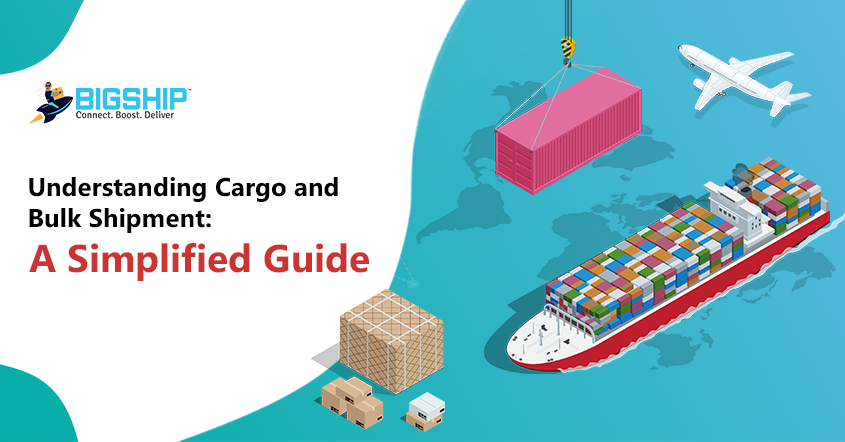Understanding Cargo and Bulk Shipment: A Simplified Guide

In the vast network of global trade, cargo shipment, and bulk shipping stand as pillars of logistical efficiency as they facilitate the movement of goods across continents. Cargo shipment encompasses the transport of various goods, ranging from small packages to large containers, utilizing various modes of transportation such as ships, planes, trains, and trucks.
On the other hand, bulk shipping specializes in the transportation of commodities in large quantities, typically including items like coal, grains, ores, and petroleum products. These shipments often fill entire cargo ships, air freights, or freight trains, optimizing economies of scale for cost-effective transportation. Both cargo shipment and bulk shipping play integral roles in sustaining supply chains and ensuring the smooth flow of goods essential to global commerce.
What is Bulk Shipping?
Bulk shipping involves transporting large quantities of goods without individual packaging. These shipments typically embark on lengthy voyages across the ocean aboard large ships, housed in metal containers. Unlike items that are individually wrapped or boxed, bulk items are loaded directly onto the ship without any packaging.
There are two main types of cargo: unitary and bulk. Unitary cargo is packaged in boxes or containers for shipment, while bulk cargo is loose and does not require packaging. The primary purpose of bulk shipping is to transport substantial amounts of cargo efficiently from one location to another, directly onto the ships. This method is commonly used for raw materials like grains, ores, and fuels, as well as for certain finished products such as chemicals or minerals.
Bulk shipping plays a vital role in global trade, facilitating the movement of large quantities of goods between countries and continents. Its efficiency and cost-effectiveness make it a preferred choice for businesses involved in bulk commodity trading and transportation.
Items Shipped in Bulk Cargo
Bulk cargo shipping transports various items, categorized into solid bulk and liquid bulk. Solid bulk includes materials like grains and ores, while liquid bulk involves liquids such as oil and chemicals. These are the primary types of bulk cargo transported through this method.
Solid Bulk Goods
Solid bulk goods, also known as dry bulk or dry cargo, include grains, minerals (such as bauxite and copper), chemicals (such as resins and fertilizers), and other items (like salt and wood). These items are usually transported from their origin using conveyors, cranes, hoppers, or silos. They’re carried by dry bulk carriers, specialized vessels designed for efficient handling of solid bulk cargo.
Liquid Bulk Goods
Liquid bulk goods include chemicals like liquid nitrogen, natural gas, petroleum, and cooking oils. Such goods are transported using pumping stations and pipelines. Specialized tankers with double hulls (body of the vessel) carry these liquids, ensuring their safety and efficiency. However, exporting smaller quantities or certain prohibited or hazardous commodities may not be suitable for liquid bulk cargo.
Working of Bulk Shipping
Shipping large quantities of goods follows similar procedures as regular shipping but requires three basic steps for proper execution. These steps include efficient planning, careful coordination of logistics, and meticulous attention to detail throughout the process. By adhering to these steps, one can successfully carry out the transportation of bulk goods. These steps are mentioned below:
Transportation at Port: Bulk goods are typically stored at the ports of origin before shipment. This involves storing your goods in a storage container within a facility or on the docks until the shipping process commences. Similar to dropshipping, these storage areas are typically owned by the shipping companies responsible for handling the loading and unloading operations. By utilizing these port facilities, shipping companies can efficiently manage the storage and movement of bulk goods, ensuring they are ready for loading onto vessels for transport to their intended destinations. This centralized storage approach organizes the logistics process and enhances overall efficiency in bulk shipping operations.
Loading In the Vessel: Once the container is prepared, it undergoes loading onto a large ship’s hull (body of the vessel) or deck. This process involves the utilization of a crane for hoisting containers onto the vessel. Remarkably, these ships can accommodate thousands of twenty-foot containers, showcasing their immense size and capability. Each container is strategically positioned to optimize the usage of the space and ensure stability during transit. This efficient loading operation allows for the transportation of vast quantities of goods across oceans, facilitating global trade and supply chain operations on a massive scale.
Unloading at the Destination: Upon reaching the destination, the process undergoes reversal, with goods unloaded from the vessel and transferred onto awaiting trucks for final-mile delivery. Alternatively, for businesses employing a consignment inventory model, goods can be directly transported to their warehousing facilities. Using this method, businesses improve efficiency, reduce handling, and speed up the shipment of goods from port to destination.
Types of Bulk Cargo
Bulk cargo comes in various forms, including break bulk, neo bulk, and containerized shipments. Each type presents unique characteristics and handling requirements, influencing transportation methods and logistics strategies accordingly.
Break Bulk
Break bulk cargo consists of goods shipped individually, rather than being packaged in containers or bulk shipments. Specialized handling and equipment are necessary for loading and unloading these items. Examples of break bulk cargo include machinery, steel, pipes, and lumber. Due to their unique characteristics, break bulk shipments require careful attention to ensure safe and efficient transportation, often involving manual labor and specific handling procedures at ports and terminals.
Neo Bulk
Neo bulk cargo refers to goods transported in large quantities, such as grains, minerals, and ores, typically in bulk carrier ships designed for such loads. These ships are engineered to accommodate vast volumes of cargo in a single voyage, optimizing efficiency and reducing transportation costs per unit. By consolidating large quantities of raw materials into a single shipment, businesses benefit from economies of scale, enhancing cost-effectiveness and streamlining supply chain operations.
Containerized
Bulk cargo can be transported in specialized containers or flexible intermediate bulk containers (FIBCs). These containers are designed to hold loose, granular, or powdered materials like grains, ores, chemicals, and construction materials. By utilizing these containers, businesses can efficiently transport large quantities of bulk goods while ensuring they remain secure and protected during transit. This method simplifies loading and unloading processes and eases the transportation of diverse types of bulk cargo.
Cargo Shipping through BigShip
BigShip is a top courier aggregator that uses AI technology to simplify logistics. Known for its exceptional customer support, BigShip offers international cargo shipping services to meet diverse needs. With weight slabs ranging from 1 ton (1000 kg) to infinite, clients benefit from flexibility in their shipment requirements. Delivery times vary between 15 to 45 days, depending upon the chosen mode of transport. Additionally, the initiation of shipment merely requires the submission of necessary documents, simplifying the process for clients. These documents are, IEC, AD Code, GST invoice, E-way bill, PAN Card, and LUT. Whether by sea, air, or land, BigShip ensures timely and efficient delivery.
Conclusion
In conclusion, cargo shipment and bulk shipping play key roles in global trade, facilitating the movement of goods across continents. Both types of shipping are essential for sustaining supply chains and ensuring the smooth flow of goods globally. Bulk shipping involves transporting large quantities of goods without individual packaging, with break bulk cargo consisting of individually shipped items and neo-bulk cargo transported in large quantities for cost-effectiveness. Containerized bulk cargo utilizes specialized containers for efficient transportation.
Efficient planning, careful coordination, and meticulous attention to detail are crucial in executing bulk shipping operations. From storage at ports to loading onto vessels and unloading at destinations, each step requires precision to ensure timely and secure delivery. With various types of bulk cargo and shipping methods available, businesses can choose the most suitable approach to meet their transportation needs, streamline logistics, and enhance overall efficiency in the supply chain.
FAQs
Ques: What is bulk cargo in shipping?
Ans: Bulk cargo in shipping refers to goods transported in large quantities without individual packaging. This includes commodities like grains, ores, liquids, and raw materials. These goods are typically loaded directly onto ships, trains, or trucks, optimizing efficiency and reducing transportation costs per unit through economies of scale.
Ques: What is the difference between cargo ship and bulk carrier?
Ans: General cargo ships primarily carry cargo, goods, and materials between ports. On the other hand, a bulk carrier, specializes in transporting vast quantities of unpackaged bulk cargo like iron ore, coal, cereal, salt, aluminum, and copper ore.
Ques: Is bulk and cargo the same?
Ans: Bulk and cargo refer to different types of goods in shipping. Cargo encompasses all types of goods transported, including packaged items, containers, and bulk cargo. Bulk cargo specifically refers to goods transported in large quantities without individual packaging, such as grains, ores, and liquids. While both are part of shipping, they represent distinct categories based on the manner of transportation.
Ques: What is dry shipping?
Ans: Dry shipping refers to the transportation of goods that are not liquid or perishable. It involves shipping items such as machinery, electronics, clothing, and furniture in containers or on cargo ships, typically over long distances.
Ques: Is coal dry bulk?
Ans: Yes, coal is considered dry bulk cargo. It is transported in large quantities without individual packaging, typically loaded directly onto bulk carrier ships or trains for transportation over long distances.
Ques: What is wet bulk?
Ans: Wet bulk refers to liquid cargo that is transported in large quantities, typically stored and transported in specialized tankers or vessels. Examples include petroleum, chemicals, liquefied natural gas (LNG), and other liquid commodities.
Ques: What is cargo handling?
Ans: Cargo handling involves the various operations conducted within warehouses and logistics centers, including the loading and unloading of cargo, transportation, storage, picking, and sorting of goods.



